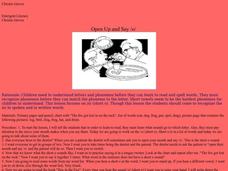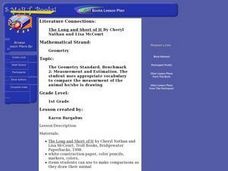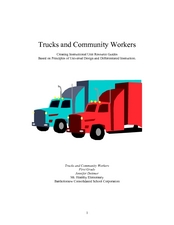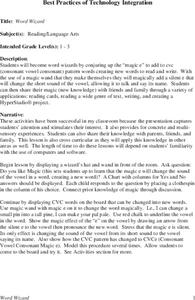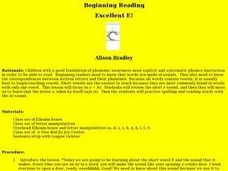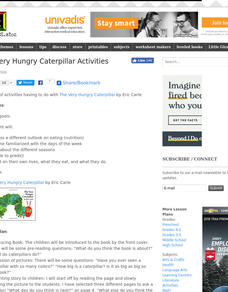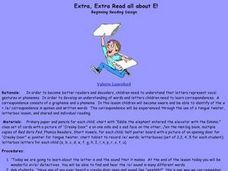Curated OER
Ah Ah Ah! Don't Do That!
Students become familiar with the alphabetic principle that letters stand for phonemes and spellings map out the phonemes in spoken words. They focus on identifying the short /o/ sound in spoken words and the tongue twister "Oscar Otter...
Curated OER
IIII---L-lll-ke---IIII-ke-and-M-IIII-ke
Students recognize the letter combination i_e by reading and spelling words with letter boxes in this instructional activity. They say a tongue twister which emphasizes the long /i/ silent /e/ combination. They then listen the story...
Curated OER
Transportation and Travel
Pupils discuss different types of travel, specifically
outlining travel arrangements requiring reservations (i.e., airplane,
bus, etc.) They work in small groups and create travel brochures then practice dialoging reservations and other...
Curated OER
Open Up and Say /o/
Learners explore letters and phonemes. They discuss the phoneme /o/. Students recognize /o/ in both spoken and written words. They discuss the shape their mouths make when saying /o/. Learners learn a tongue twister to help them identify...
Curated OER
Things That Make You Say Aaaa!
Students discuss how to identify the a=/a/ in spoken words. They discuss a meaningful representation for the sound and a letter symbol. They identify the /a/ sound in words. Students read a story and blink their eyes when they hear the...
Curated OER
The Long and Short of It - Geometry
First graders use appropriate vocabulary to compare the measurement of the animal he/she is drawing.
Curated OER
I Can Read With Expression
Learners practice reading fluently and expressively through the use of various strategies. After reviewing chunking, decoding, and rereading, students complete an initial read of a novel text. They create a deck of expression cards to...
Curated OER
Reader Rabbit 1
Second graders participate in a reading lesson in order to improve phonics skills. They generate the short vowel sound in CVC pattern words. Students blend beginning consonant, short vowel sound and final consonant into words.
Curated OER
Trucks and Community Workers
First graders identify community helpers and their roles. In this transportation lesson plan, 1st graders complete a series of lessons integrating technology and literacy. Students decode sounds of short u, c/s/ and g/j/ words and...
Curated OER
ESOL Personal Information
Students view different vocabulary cards with personal information words. They match pairs of cards with personal information vocabulary. They complete an information form and read their information to the class.
Curated OER
Word Wizard
Students make magic wands to become word wizards who add the magic "e" to word with cvc patterns. They make reading cards, and a multimedia presentation show the use of the word patterns.
Curated OER
Beginning Reading Design: Blending Boats
Students study how to blend the sounds together in words with the CVC form. They use letter cards and the books, "Tin Man Fix-It," and Dr. Seuss', Green Eggs and Ham. They work with /m/ words to blend the sounds together to read words....
Curated OER
Excellent E!
Students explore the short /e/ sound. They practice making the sound and recite an 'e' tongue twister. They practice writing the letter e and use Elkonin letter boxes to spell e words. In groups, they read stories and identify short /e/...
Curated OER
Building a Sentence
First graders echo a sentence targeting a vowel selected by the teacher and shown on a sentence strip. In this sentence building instructional activity, 1st graders put the cut up sentence strip back into correct order, repeating the...
Curated OER
The Very Hungry Caterpillar
Students participate in activities associated with the book, "The Very Hungry Caterpillar". They practice using new vocabulary and the days of the week. They create a book about what they ate on the different days of the week and how the...
Curated OER
ADULT ESOL LESSON PLAN--Skills Necessary to Listen, Speak, Read and Write Effectively
Students, using a basic word picture dictionary, review the vocabulary terms on the board in conjunction with the picture dictionary and tie the two together for placement association. In addition, they practice using key grammar words...
Curated OER
"Ca...Ca...Ca...Caterpillar Blending"
Young scholars improve blending skills. They produce many individual short utterances and mouth moves (phonemes) into one long utterance (words) and create their own blending caterpillar. They draw a picture of a caterpillar with...
Curated OER
ESOL: Health and Nutrition
Students explore the four food groups and how they contribute to one's health. They identify the four food groups and create a poster of the four food groups with pictures. They present their posters to the class and practice answering...
Curated OER
Extra, Extra Read all about E!
Learners examine the letter 'e'. Through instruction and modeling they explore the sound the letter makes, how the letter is written, etc. They recite tongue twisters and use letterboxes to write 'e' words. They pick out short /e/ words...
Curated OER
What Do Seals Eat?
Students recognize the ea=/E/ correspondence in spoken and written words. They participate in a group letterbox lesson plan. In groups of two, they practice reading with each other, taking turns reading one page at a time, identifying...
Curated OER
Secret Stories: Exploring the Elements of Folktales and Fables
Students are introduced to the characteristics of fables and folktales. In groups, they read and identify the various elements in the stories they read from around the world. For each story, they analyze the setting and the various...
Curated OER
Can you Top That?
Students make connections between their own experiences and the story, "get" the author's message and be able to discuss it with other readers, and apply their reading skills and strategies. They predict what happens in the story,...
Curated OER
Letter Names
Students explore language arts by participating in a letter identification activity. In this word recognition lesson, students are shown a list of vocabulary terms which they practice reciting with their classmates. Students identify and...
Alabama Learning Exchange
Tornadoes
Students research tornadoes. For this weather lesson, students construct a KWL chart on tornadoes and view the video National Geographic-Tornadoes. Students discuss the facts they learned from the film and complete the KWL chart.





